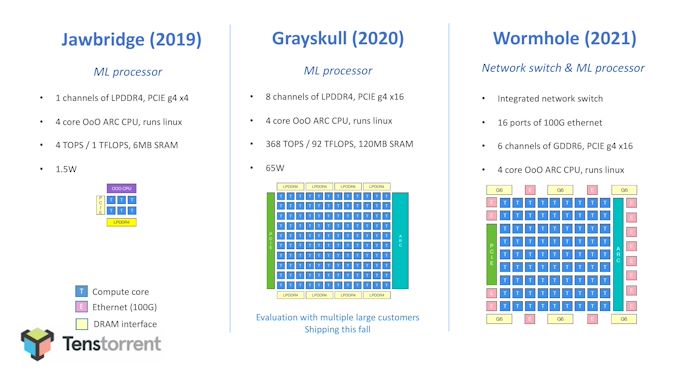Jim Keller Becomes CTO at Tenstorrent: "The Most Promising Architecture Out There"
by Dr. Ian Cutress on January 5, 2021 9:50 PM EST- Posted in
- CPUs
- SoCs
- AI
- Jim Keller
- ML
- Tenstorrent
- Greyskull
- Wormhole

It is high praise when someone like Jim Keller says that your company ‘has made impressive progress, and has the most promising architecture out there’. That praise means twice as much if Keller actually joins the company. Today Tenstorrent is announcing that Jim Keller, compute architect extraordinaire, has joined the company as its Chief Technology Officer, President, and joins the company board.
To our regular audience, Jim Keller is a known expert in all things computer architecture. His history starts at DEC, designing Alpha processors, before moving to a first stint at AMD for two years working to launch K7 and K8. Keller spent four years as Chief Architect at SiByte/Broadcom designing MIPS for network interfaces, four years at P.A. Semi, four years at Apple (A4+A5), then back to AMD for three years two years as Corporate VP and Chief Cores Architect in charge of the new generation of CPU architectures, K12 and Zen. This was then followed with two years at Tesla as VP of Autopilot Hardware Engineering creating the Full Self-Driving chip, then two years as Intel’s Senior VP of the Silicon Engineering Group, before leaving in June 2020. Since his departure from Intel, a number of key industry analysts (and ourselves) have been guessing where Jim would land. He briefly appeared in the audience of Elon Musk’s Neuralink presentation in August 2020, alongside Lex Fridman.
| Jim Keller: Work Experience | ||||
| AnandTech | Company | Title | Important Product |
|
| 1980s | 1998 | DEC | Architect | Alpha |
| 1998 | 1999 | AMD | Lead Architect | K7, K8 |
| 1999 | 2000 | SiByte | Chief Architect | MIPS Networking |
| 2000 | 2004 | Broadcom | Chief Architect | MIPS Networking |
| 2004 | 2008 | P.A. Semi | VP Engineering | Low Power Mobile |
| 2008 | 2012 | Apple | VP Engineering | A4 / A5 Mobile |
| 8/2012 | 9/2015 | AMD | Corp VP and Chief Cores Architect |
Skybridge / K12 (+ Zen) |
| 1/2016 | 4/2018 | Tesla | VP Autopilot Hardware Engineering |
Fully Self-Driving (FSD) Chip |
| 4/2018 | 6/2020 | Intel | Senior VP Silicon Engineering |
? |
| 2021 | Tenstorrent | President and CTO | TBD | |
Today Tenstorrent reached out to inform us that Jim Keller has taken the position of President and Chief Technology Officer of the company, as well as being a member of its Board of Directors. Jim's role, based on his previous expertise, would appear to be in the design of future products for the company as well as building on the team at Tenstorrent to succeed in that goal.
CEO Ljubisa Bajic confirmed Jim’s appointment as President and CTO of the company, stating that:
Tenstorrent was founded on the belief that the ongoing shift towards ML-centric software necessitates a corresponding transformation in computational capabilities. There is nobody more capable of executing this vision than Jim Keller, a leader who is equally great at designing computers, cultures, and organizations. I am thrilled to be working with Jim and beyond excited about the possibilities our partnership unlocks.
Tenstorrent is a pure-play fab-less AI chip design and software company, which means that they create and design silicon for machine learning, then use a foundry to make the hardware, then work with partners to create solutions (as in, chips + system + software + optimizations for that customer). For those that know this space, this makes the company sound like any of the other 50 companies out in the market that seem to be doing the same thing. The typical split with pure-play fabless AI chip design companies is whether they are focused on training or inference: Tenstorrent does both, and is already in the process of finalizing its third generation processor.
Founded in 2016, Tenstorrent has around 70 employees between Toronto and Austin. The critical members of the company all have backgrounds in silicon design: the CEO led power and performance architecture at AMD as well as system architecture for Tegra at NVIDIA, the head of system software spent 16 years across AMD and Altera, and there’s expertise from neural network accelerator design from Intel, GPU systems engineering at AMD, Arm CPU verification leads, IO virtualization expertise at AMD, Intel’s former neural network compiler team lead, as well as AMD’s former security and network development lead. It sounds like Jim will fit right in, as well as have a few former colleagues working alongside him.
Tenstorrent’s current generation product is Grayskull, a ~620mm2 processor built on GF’s 12nm that was initially designed as an inference accelerator and host. It contains 120 custom cores in a 2D bidirectional mesh, and offers 368 TeraOPs of 8-bit compute for only 65 W. Each of the 120 custom cores has a packet management engine for data control, a packet compute engine that contains Tenstorrent’s custom TENSIX cores, and five RISC cores for non-standard operations, such as conditionals. The chip focuses on sparse tensor operations by optimizing matrix operations into compressed packets, enabling pipeline parallelization of the compute steps both through the graph compiler and the packet manager. This also enables dynamic graph execution, and compared to some other AI chip models, allows both compute and data transfer asynchronously, rather than specific compute/transfer time domains.
Grayskull is currently shipping to Tenstorrent’s customers, all of which are still undisclosed.
The next generation chip, known as Wormhole, is more focused on training than acceleration, and also bundles in a 16x100G Ethernet port switch. The move from training to acceleration necessitates a faster memory interface, and so there are six channels of GDDR6, rather than 8 channels of LPDDR4. This might seem low compared to other AI chips discussing HBM integration, however Tenstorrent’s plan here seems to be more aligned for more mid-range cost structure, but also offering machine learning compute at a better rate of efficiency than those chips pushing the bleeding edge of frequency and process node (part of this will be in yields as well).
So where exactly does Keller fit in if the current generation is already selling, and the next generation is almost ready to go? In speaking to the CEO, I confirmed that Keller ‘will be building new and interesting stuff with us’. This seems to suggest that the vision with Keller’s involvement is going to be on 2022/2023 hardware in mind, following Tenstorrent’s overriding Software 2.0 strategy that the hardware, compiler, and run-time offer a full-stack approach to sparse (and dense) AI matrix calculations. In Jim’s own words:
Software 2.0 is the largest opportunity for computing innovation in a long time. Victory requires a comprehensive re-thinking of compute and low level software. Tenstorrent has made impressive progress, and with the most promising architecture out there, we are poised to become a next gen computing giant.
Jim Keller officially started last Wednesday, and the official wire announcement is set for 1/6, but we've been allowed to share in advance. Our request for an interview with Jim has been noted and filed, potentially for a few months down the line as the company has some more details on its platform and roadmap (I’ve also asked for an up-to-date headshot of Jim!). For those interested, I interviewed Jim back in July 2018, just after he started at Intel – you can read that interview here.
Related Reading
- Hot Chips 32 (2020) Schedule Announced: Tenstorrent
- Jim Keller Resigns from Intel, Effective Immediately
- An AnandTech Exclusive: The Jim Keller Interview
- CPU Design Guru Jim Keller Joins Intel; Completes CPU Grand Tour
- Jim Keller Leaves AMD
- AMD Announces Project SkyBridge: Pin-Compatible ARM and x86 SoCs in 2015, Android Support
- Apple A4/A5 Designer & K8 Lead Architect, Jim Keller, Returns to AMD













66 Comments
View All Comments
mode_13h - Saturday, January 9, 2021 - link
Exactly what scale of project are you proposing that fewer people could do? If you just want to slap together something that works, it's probably easier than ever.But, if you want it to be competitive, then the ever-increasing complexity of higher-level structures and all the nuances involved in architecturally balancing everything optimally and minimizing power usage is a monumental undertaking. It requires chip simulations and analysis of different software on your architecture, in order to find bottlenecks and unused capacity.
And it used to be that a lot of time was spent hand-designing low-level building blocks, which automated tools simply didn't do as well as human designers. I don't know if that's still true.
Oberoth - Wednesday, January 6, 2021 - link
I totally agree, the work he did at Apple set in motion the amazing chips we have today, the work he did at AMD has given us the world changing Zen chips and we can only cross our fingers that he had enough time at Intel to complete some designs so he can reshape the future again.I think we all know the real reason Jim was forced to leave Intel and that guy was kicked out a few months later anyway so I was really hoping Intel would apologise to Jim and rehire him to finish his work.
ljwobker - Tuesday, January 5, 2021 - link
looks like a six month non-compete may have just run out... will be interesting to see what gets cranked out here...SydneyBlue120d - Wednesday, January 6, 2021 - link
I had expected him to land in VW group, really curious to know how he will change history once again.Desierz - Wednesday, January 6, 2021 - link
Never heard of them before, but I initially wondered why Jim Keller would work for a P2P company.Anne - Wednesday, January 6, 2021 - link
Yes your indeed.k_sze - Wednesday, January 6, 2021 - link
There's a slight problem in the article:> The next generation chip, known as Wormhole, is more focused on training than acceleration, and also bundles in a 16x100G Ethernet port switch. The move from training to acceleration necessitates a faster memory interface, and so there are six channels of GDDR6, rather than 8 channels of LPDDR4.
These two sentences seem to contradict each other: is Wormhole actually focused on training or on acceleration?
Rudde - Wednesday, January 6, 2021 - link
The current gen chip is an inference accelerator and the next gen moves from acceleration to training. Wormhole is focused on training.romrunning - Wednesday, January 6, 2021 - link
So the sentence saying "The move from training to acceleration necessitates..." in connection with the new hardware on the Wormhole product should really be written as "The move from acceleration to training necessitates..."mode_13h - Wednesday, January 6, 2021 - link
I'm sure this notion will fly like a lead balloon, but I wonder how much they hired him for his name vs. his actual capabilities. No doubt he's a smart guy, but I find all the hype around him a bit hard to swallow.Even if he was truly instrumental in some of his more notable prior accomplishments, can he really have kept abreast of all the developments in CPU design well enough that he's *still* that far above and beyond most others?